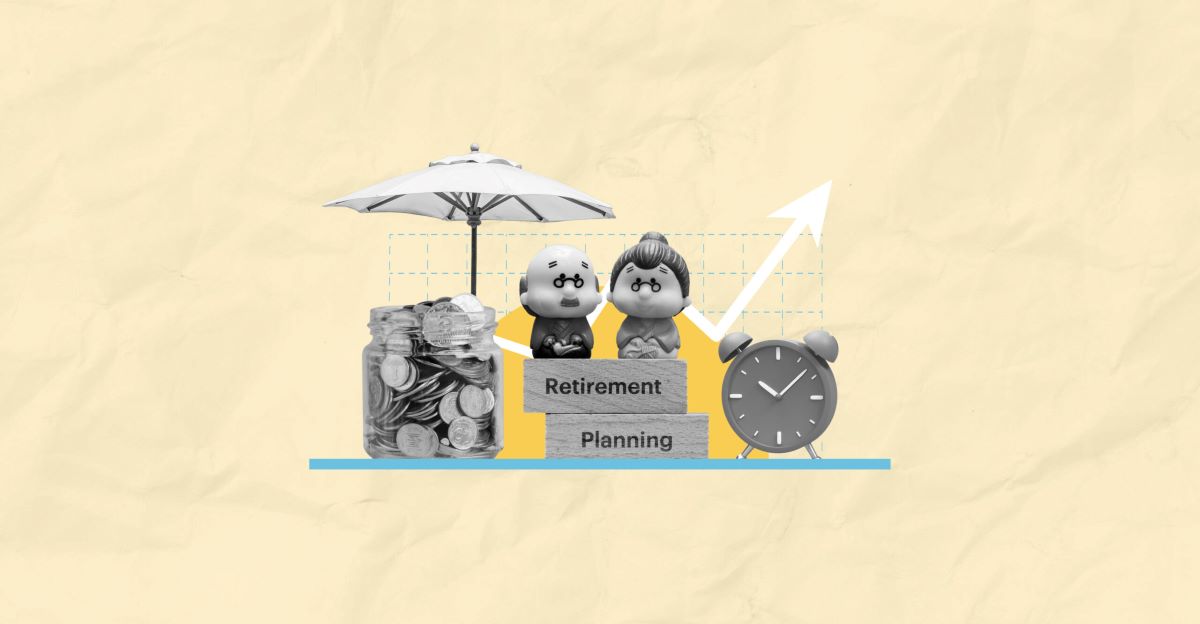

Finance
What Is The Process Of Retirement Planning
Published: January 21, 2024
Learn the process of retirement planning and secure your future. Discover how financial management in retirement can help you achieve your financial goals.
(Many of the links in this article redirect to a specific reviewed product. Your purchase of these products through affiliate links helps to generate commission for LiveWell, at no extra cost. Learn more)
Table of Contents
- Introduction
- Understanding Retirement Planning
- Setting Financial Goals for Retirement
- Assessing Retirement Income Sources
- Evaluating Expenses and Budgeting for Retirement
- Creating a Retirement Savings Plan
- Investing and Growing Retirement Funds
- Managing Retirement Risks and Uncertainties
- Adjusting Plans for Life Changes
- Seeking Professional Retirement Planning Help
- Conclusion
Introduction
Retirement planning is a crucial process that everyone should engage in to ensure a comfortable and secure future. It involves making informed decisions about finances, investments, and lifestyle choices to achieve financial independence after leaving the workforce. While retirement may seem far off for many individuals, it’s never too early to start planning for this significant life stage. Your retirement years can be the best time of your life, filled with freedom, relaxation, and the pursuit of lifelong dreams.
In this article, we will explore the process of retirement planning and provide insights on how to create a solid retirement plan that suits your unique needs and aspirations. We will cover various aspects of retirement planning, including setting financial goals, assessing income sources, evaluating expenses, creating a savings plan, investing wisely, managing risks, and adjusting plans for life changes.
Retirement planning requires careful consideration of personal circumstances and financial capabilities. It’s not just about saving a specific amount of money but also about envisioning your desired lifestyle and determining how much you will need to sustain it. Through thoughtful planning and effective strategies, you can take control of your financial future and enjoy a fulfilling retirement.
While this article aims to provide valuable insights into retirement planning, it’s important to note that everyone’s financial situation is unique. It’s always recommended to consult with a financial advisor to tailor a retirement plan specifically to your needs and goals.
Now, let’s delve deeper into the process of retirement planning, step by step, to help you understand the key considerations and decisions you need to make along the way.
Understanding Retirement Planning
Retirement planning is the process of determining your financial goals and creating a strategy to ensure a comfortable retirement. It involves evaluating your income sources, estimating your expenses, and developing a savings and investment plan to fund your retirement years. Retirement planning not only allows you to maintain your desired standard of living but also helps you prepare for unforeseen circumstances and enjoy financial stability during your golden years.
There are several key aspects to understand when it comes to retirement planning:
- Retirement Age: The age at which you plan to stop working and live off your accumulated savings and investments. This age can vary depending on personal preferences, employer retirement policies, and government regulations.
- Life Expectancy: Your expected lifespan plays a crucial role in retirement planning. It helps determine how long your retirement funds need to last and influences the amount you need to save.
- Social Security: Social Security benefits can be an essential source of income during retirement. Understanding how Social Security works and the eligibility criteria is crucial for planning purposes.
- Healthcare Costs: Healthcare expenses tend to increase as we age, making it essential to factor in healthcare costs when planning for retirement. Consider healthcare insurance options and potential long-term care expenses.
- Inflation: Inflation erodes the purchasing power of money over time. It’s important to account for inflation when estimating future expenses and income needs during retirement.
Retirement planning is not solely about monetary aspects. It also involves envisioning your desired retirement lifestyle. Consider the activities you would like to pursue, any travel plans, hobbies, or philanthropic endeavors. These factors can guide your financial planning decisions and help you budget for a fulfilling retirement.
Furthermore, retirement planning is an ongoing process that requires periodic review and adjustments. As you progress through different life stages, your financial situation and goals may change. Regularly reassessing your retirement plan allows you to adapt to new circumstances and ensure that you stay on track to meet your objectives.
Now that we have an understanding of retirement planning, let’s move on to the next step: setting financial goals for retirement.
Setting Financial Goals for Retirement
Setting clear financial goals is a crucial step in retirement planning. It helps you determine the target amount you need to save and provides direction for your savings and investment strategies. When setting financial goals for retirement, consider the following factors:
- Lifestyle: Determine the lifestyle you envision for your retirement. Consider your desired level of comfort, location, travel plans, hobbies, and any other activities you wish to pursue. This will give you a better idea of the expenses you will need to cover.
- Income Replacement: Assess how much of your pre-retirement income you will require in retirement. As a general guideline, experts recommend aiming for around 70-80% of your pre-retirement income to maintain a similar standard of living.
- Retirement Duration: Estimate how many years your retirement is likely to span. Keep in mind that people are living longer, so it’s advisable to plan for a longer retirement period.
- Inflation and Healthcare Costs: Factor in inflation and potential healthcare expenses when determining your financial goals. Account for the rising cost of living and allocate funds for healthcare coverage and medical emergencies.
- Debts and Mortgages: Consider any outstanding debts or mortgages that you need to pay off before retiring. It’s important to enter retirement with as few financial obligations as possible.
Once you have a clear understanding of your financial goals, you can calculate the amount you need to save for retirement. Take into account your existing savings, expected Social Security benefits, and other income sources. The difference between your financial goals and projected income determines the amount you need to accumulate.
To reach your retirement savings goal, create a realistic timeline and break it down into manageable milestones. Determine how much you need to save each month or year and adjust your budget accordingly. Automating your savings through a retirement account, such as a 401(k) or an Individual Retirement Account (IRA), can help you stay disciplined and maximize your savings.
Remember, setting financial goals for retirement is not a one-time activity. Revisit and reassess your goals regularly to ensure they align with your changing financial circumstances and aspirations. As you progress in your career and approach retirement age, you may have a clearer picture of your income potential and retirement needs, allowing you to make more accurate projections and adjustments.
Now that we have established the importance of setting financial goals, let’s move on to the next step: assessing retirement income sources.
Assessing Retirement Income Sources
Assessing your retirement income sources is a crucial step in retirement planning. It involves evaluating the various streams of income you will have during your retirement years. By understanding and optimizing these income sources, you can ensure a steady and comfortable income throughout your retirement. Here are some common retirement income sources to consider:
- Employer-Sponsored Retirement Plans: If you have a workplace retirement plan, such as a 401(k) or a pension, it can be a significant income source in retirement. Determine the value of your contributions and any matching contributions made by your employer, as these funds will play a pivotal role in funding your retirement.
- Social Security Benefits: Most individuals are eligible to receive Social Security benefits during retirement. Explore the Social Security Administration’s website or consult with a financial advisor to understand your estimated benefits based on your earnings history and retirement age. Understanding the best time to claim your benefits is crucial to maximize your monthly payments.
- Personal Savings and Investments: Assess the savings and investments you have accumulated over the years. This can include savings accounts, certificates of deposit, stocks, bonds, mutual funds, and real estate properties. Evaluate their projected value and consider how you can optimize these assets to generate income during retirement.
- Part-Time Work: Some individuals choose to continue working part-time during retirement to supplement their income and stay engaged. Assess the viability of working part-time in your desired field or explore other opportunities that align with your interests and skills.
- Individual Retirement Accounts (IRAs): If you have an IRA, whether traditional or Roth, evaluate its value and projected income. Consider the tax implications and withdrawal rules associated with these accounts.
- Rental Properties: If you own rental properties, assess their income potential and expenses. Rental income can provide a stable source of cash flow during your retirement years.
By assessing and understanding your retirement income sources, you can determine how much income you can expect to receive and identify any potential gaps. This knowledge will help you make informed decisions about saving, investing, and strategizing additional income streams if needed.
In addition to assessing your income sources, it’s essential to understand the tax implications of each source. Different income streams may be subject to different tax treatments, so consult with a tax professional to optimize your tax strategy and minimize your tax liabilities during retirement.
Now that we have evaluated retirement income sources, let’s move on to the next step: evaluating expenses and budgeting for retirement.
Evaluating Expenses and Budgeting for Retirement
Evaluating expenses and creating a budget is a crucial component of retirement planning. By understanding your expected expenses and creating a realistic budget, you can ensure that your retirement income will be sufficient to cover your needs and desired lifestyle. Here are some steps to take when evaluating expenses and budgeting for retirement:
- Track Current Expenses: Start by tracking your current expenses to get a clear understanding of your spending habits. This will serve as a baseline for estimating your future retirement expenses.
- Identify Essential and Discretionary Expenses: Categorize your expenses into essential and discretionary categories. Essential expenses include housing, food, healthcare, utilities, and transportation, while discretionary expenses cover entertainment, travel, and hobbies.
- Consider Inflation: Take into account the impact of inflation when projecting your future expenses. The cost of goods and services tends to increase over time, so it’s crucial to factor in inflation when setting your budget.
- Factor in Healthcare Costs: Healthcare expenses tend to rise with age, so it’s important to budget for medical expenses, including insurance premiums, prescription drugs, and potential long-term care costs.
- Plan for Debt Repayment: Evaluate your outstanding debts and create a plan to pay them off before retirement. Car loans, credit card debt, and mortgages can significantly impact your retirement budget, so it’s advisable to enter retirement with as little debt as possible.
- Account for Taxes: Understand the tax implications of your retirement income sources. Some income, such as distributions from traditional IRAs or 401(k)s, may be taxable, while others, like withdrawals from a Roth IRA, may not. Consider how taxes will affect your budget and adjust your savings and investment strategies accordingly.
Once you have evaluated your expenses, create a retirement budget that aligns with your income sources and financial goals. Your budget should reflect your anticipated expenses during retirement and account for any changes in your lifestyle or circumstances. Be realistic but also allow some flexibility for unexpected expenses and emergencies.
Regularly review and revise your budget as circumstances change. As you progress through retirement, your expenses may vary, and adjustments may be necessary. A budget can help you maintain financial discipline and ensure that you are on track to achieve your retirement goals.
Now that we have evaluated expenses and created a budget, let’s move on to the next step: creating a retirement savings plan.
Creating a Retirement Savings Plan
Creating a retirement savings plan is a crucial step in ensuring a financially secure future. It involves determining how much you need to save and developing a strategy to accumulate the necessary funds. By taking a proactive approach to saving for retirement, you can maximize your savings and increase the likelihood of achieving your financial goals. Here are some steps to help you create a retirement savings plan:
- Set Savings Goals: Determine the target amount you need to save for retirement based on your financial goals and estimated expenses. Consider factors such as inflation, healthcare costs, and your desired lifestyle to set realistic savings goals.
- Calculate Saving Contributions: Once you have set your savings goals, calculate how much you need to save each month or year to reach those goals. Use retirement calculators or consult with a financial advisor to determine the required contribution amount.
- Automate Savings: Set up automatic transfers from your paycheck or bank account to your retirement savings account. Automating your savings makes it easier to stay consistent and disciplined in your saving habits.
- Maximize Employer Contributions: If your employer offers a retirement plan with matching contributions, contribute enough to maximize the employer match. It’s essentially free money that can significantly boost your retirement savings.
- Consider Tax-Advantaged Accounts: Explore retirement savings options such as a 401(k), a traditional IRA, or a Roth IRA. These accounts offer tax advantages, such as tax-deferred growth or tax-free withdrawals, depending on the account type.
- Diversify Investments: Diversify your retirement investments to reduce risk and potentially increase returns. Consider a mix of stocks, bonds, mutual funds, and other investment options to build a well-rounded portfolio.
- Review and Adjust Regularly: Regularly review your retirement savings plan to ensure it aligns with your changing circumstances and goals. Adjust your contributions, investment strategy, and savings goals as needed.
Remember, the key to a successful retirement savings plan is consistency and discipline. Make saving for retirement a priority, even if it means making sacrifices or adjusting your spending habits. Every dollar you save now will compound over time and help secure a comfortable retirement.
Additionally, regularly review your retirement plan to account for life changes, such as marriage, children, or career advancements. These changes may require adjustments to your savings strategy to ensure you stay on track to reach your retirement goals.
Now that we have created a retirement savings plan, let’s move on to the next step: investing and growing retirement funds.
Investing and Growing Retirement Funds
Investing and growing your retirement funds is a critical step in building a secure financial future. By strategically investing your savings, you can potentially increase your returns and grow your retirement nest egg over time. Here are some key considerations to keep in mind when investing for retirement:
- Asset Allocation: Determine an appropriate asset allocation based on your risk tolerance, time horizon, and financial goals. Consider diversifying your investments across different asset classes, such as stocks, bonds, and real estate, to spread risk and potentially enhance returns.
- Investment Vehicles: Choose suitable investment vehicles for your retirement savings, such as mutual funds, exchange-traded funds (ETFs), or individual stocks and bonds. Consider factors such as fees, historical performance, and the expertise of fund managers, and seek professional advice if needed.
- Long-Term Focus: Maintain a long-term perspective when investing for retirement. Investing in stocks or other growth-oriented assets can help you benefit from compounding returns over time. Be prepared for market fluctuations and avoid making short-term investment decisions based on market volatility.
- Regular Monitoring: Regularly review and monitor your investments to ensure they are aligned with your financial goals. Rebalance your portfolio periodically to maintain the desired asset allocation and adjust your investments as market conditions or personal circumstances change.
- Consider Professional Advice: If you are uncertain about investment strategies or lack the time and expertise to manage your portfolio, consider seeking advice from a professional financial advisor. They can provide personalized guidance and help optimize your investment strategy.
- Manage Investment Costs: Pay attention to investment costs, such as expense ratios and transaction fees. High costs can eat into your returns over time. Consider low-cost index funds or passively managed funds as they tend to have lower fees compared to actively managed funds.
- Risk Management: As you near retirement, gradually shift your asset allocation to include more conservative investments to protect your savings from market downturns. Balancing risk and reward becomes crucial as you rely on your investments to generate income during retirement.
Remember that investing involves risks, and past performance is not indicative of future results. It’s important to do thorough research, diversify your investments, and make informed decisions based on your own risk tolerance and financial goals.
Consider regular contributions to your retirement savings, taking advantage of tax-advantaged accounts, such as an employer-sponsored 401(k) plan or an individual retirement account (IRA). Maximizing your contributions to these accounts can provide tax benefits and accelerate your retirement savings growth.
By investing wisely and staying disciplined, you can potentially grow your retirement funds and increase the likelihood of achieving your financial objectives. Regularly monitor your investments, adapt to market conditions, and seek professional advice when needed to make informed decisions.
Now that we have explored investing and growing retirement funds, let’s move on to managing retirement risks and uncertainties.
Managing Retirement Risks and Uncertainties
Managing retirement risks and uncertainties is an essential aspect of retirement planning. While you cannot always control the future, you can take steps to mitigate potential risks and ensure a more secure retirement. Here are some key risks and uncertainties to consider and strategies to manage them:
- Market Volatility: Economic downturns and market fluctuations can significantly impact your retirement savings. Diversification, asset allocation, and a long-term perspective can help mitigate the effects of market volatility. Avoid making impulsive investment decisions based on short-term market movements.
- Longevity Risk: Longevity risk refers to the possibility of outliving your savings. As people are living longer, it’s important to plan for a longer retirement period. Consider strategies such as annuities or systematic withdrawal plans that provide a steady income stream throughout your retirement years.
- Inflation: Inflation erodes the purchasing power of your money over time. Account for inflation when estimating your future expenses and ensure that your investment returns outpace inflation to maintain your standard of living. Consider investing in assets that historically offer some protection against inflation, such as stocks and real estate.
- Healthcare Costs: Healthcare expenses can be a significant financial burden during retirement. Evaluate your healthcare coverage options and consider long-term care insurance to protect against potential high costs. Stay proactive about maintaining your health and wellness to minimize healthcare expenses.
- Withdrawal Rate: Determining a sustainable withdrawal rate is crucial to make your retirement savings last. Plan for a withdrawal rate that aligns with your financial goals and allows for potential market fluctuations. Consider the 4% rule as a starting point, but adjust based on your personal circumstances and risk tolerance.
- Unexpected Life Events: Prepare for unexpected life events, such as a job loss, illness, or a major financial setback. Maintain an emergency fund to cover unforeseen expenses and consider having adequate insurance coverage for protection. Regularly review and update your insurance policies to ensure they meet your needs.
Additionally, regularly reassess your retirement plan to accommodate changes in your personal circumstances or financial goals. Life events like marriage, divorce, the birth of a child, or the death of a loved one may require adjustments to your retirement savings, investments, and estate planning strategies.
Seeking guidance from a financial advisor can be beneficial in managing retirement risks and uncertainties. A professional can help you identify potential risks, analyze your financial situation, and recommend appropriate strategies to protect and enhance your retirement savings.
Remember, retirement planning is an ongoing process. Stay informed, stay proactive, and regularly review and adjust your retirement plan to adapt to changing circumstances and optimize your financial security.
Now let’s move on to the next step: adjusting plans for life changes.
Adjusting Plans for Life Changes
Life is full of unexpected twists and turns, and it’s essential to adjust your retirement plans to accommodate these changes. As you progress through different life stages, your financial situation, goals, and priorities may evolve. Here are some key factors to consider when adjusting your retirement plans:
- Marriage and Divorce: Getting married or divorced can have a significant impact on your retirement plans. Assess the financial implications of these life events, such as combining or separating finances, adjusting beneficiary designations, and updating your estate plans.
- Childbirth and Parenthood: The arrival of a child brings new financial responsibilities. Review your budget and savings plan to accommodate the costs of raising a child, such as education expenses and healthcare needs. Consider adjusting your insurance coverage and planning for their future financial well-being.
- Career Changes: Job changes, promotions, or career shifts can impact your retirement plans. Assess the impact of these changes on your income, benefits, and retirement savings. Adjust your contributions and investment strategies accordingly to ensure your retirement plan stays on track.
- Healthcare Needs: Changes in your health condition or that of a loved one can have financial implications. Review your healthcare coverage, insurance policies, and long-term care plans to ensure you are adequately prepared for potential healthcare costs in retirement.
- Unexpected Expenses or Windfalls: Whether it’s an unexpected expense, such as home repairs or a major medical bill, or a windfall, such as an inheritance or a significant bonus, these financial changes can impact your retirement plans. Reassess your savings and investment strategies to accommodate these fluctuations and adjust your retirement timeline if necessary.
- Volunteering or Second Career: Some individuals choose to volunteer or embark on a second career during retirement. Consider the potential financial impact of these activities and adjust your retirement plans accordingly. Determine if any additional income or expenses need to be factored in, and reassess your budget and savings goals accordingly.
Regularly revisit and revise your retirement plans to ensure they align with your current situation and aspirations. Life changes may require adjustments to your savings rate, investment strategy, retirement timeline, or even your desired retirement lifestyle.
Seeking guidance from a financial advisor can be valuable when adjusting your retirement plans for life changes. A professional can help you navigate the financial complexities of these transitions and provide personalized advice based on your unique circumstances.
Remember, flexibility and adaptability are essential in retirement planning. By regularly assessing and adjusting your plans, you can stay on track to achieve your retirement goals and maintain financial security.
Now that we have explored adjusting plans for life changes, let’s move on to seeking professional retirement planning help.
Seeking Professional Retirement Planning Help
Retirement planning can be complex and overwhelming, especially when considering the various financial factors and uncertainties involved. Seeking professional retirement planning help can provide valuable guidance and expertise to ensure you make informed decisions and build a solid retirement strategy. Here are some reasons why you should consider consulting a professional:
- Expertise and Knowledge: Retirement planning professionals have expertise and knowledge in the field of finance and retirement. They stay updated with the latest industry trends, investment strategies, tax regulations, and retirement planning best practices. Their knowledge can help you make informed choices and optimize your retirement plan.
- Individualized Tailoring: Every individual’s financial situation and retirement goals are unique. A professional can assess your personal circumstances, goals, and risk tolerance to customize a retirement plan that aligns with your specific needs. They can help identify potential gaps and provide solutions to bridge those gaps.
- Maximizing Retirement Benefits: Professionals have in-depth knowledge of retirement benefits, such as Social Security, pensions, and employer-sponsored plans. They can guide you on how to maximize these benefits, take advantage of tax-saving opportunities, and optimize your retirement income sources.
- Investment Strategies: Retirement planning professionals can offer valuable insights on investment strategies that align with your goals. They can help you navigate the complexities of asset allocation, diversification, and risk management, ensuring your investments are well-positioned for growth while considering your risk tolerance.
- Continuous Monitoring and Adjustments: A professional can provide ongoing monitoring of your retirement plan, making adjustments and recommendations as needed. They can help you stay on track with your financial goals and adapt your plan as life circumstances, market conditions, and personal objectives change.
- Estate Planning: Retirement planning often involves estate planning considerations. A professional can help you develop an estate plan, including wills, trusts, and beneficiary designations. They can ensure that your assets are protected, and your desired legacy is passed on efficiently and according to your wishes.
When seeking professional retirement planning help, choose a qualified and reputable financial advisor or retirement planner. Look for certifications such as Certified Financial Planner (CFP) or Chartered Retirement Planning Counselor (CRPC), which indicate expertise and a commitment to professional standards.
Remember that hiring a professional does come with costs, so consider the fees and services offered before making a decision. It’s also important to establish a good rapport and trust with the professional you choose, as they will be responsible for guiding you through your retirement journey.
Ultimately, seeking professional retirement planning help can provide you with peace of mind, confidence in your financial decisions, and the reassurance that you are on the right track towards a secure and fulfilling retirement.
Now that we have explored the benefits of seeking professional retirement planning help, let’s conclude our article.
Conclusion
Retirement planning is a dynamic and essential process that empowers individuals to secure their financial future and enjoy a comfortable retirement. By following the steps outlined in this article, including understanding retirement planning, setting financial goals, evaluating income sources, budgeting for expenses, creating a savings plan, investing wisely, managing risks, adjusting plans for life changes, and seeking professional guidance, you can establish a solid foundation for your retirement journey.
Remember that retirement planning is a lifelong endeavor that requires regular monitoring and adjustments. As you progress through different life stages, your financial circumstances, goals, and priorities may change. Stay proactive, periodically revisit your retirement plan, and make any necessary updates to ensure it remains aligned with your evolving needs.
While this article provides valuable insights, it is important to personalize your retirement strategy based on your unique circumstances. Consider consulting with a financial advisor or retirement planning professional who can provide individualized guidance tailored to your specific goals and needs.
By taking control of your retirement planning today, you can enjoy the peace of mind and financial security that come with a well-prepared future. Start planning early, stay disciplined, and make informed decisions to embark on a retirement journey filled with fulfillment, freedom, and financial independence.
Now it’s time to take the first step towards your retirement dreams and start crafting your personalized retirement plan. Best of luck on your journey to a happy and financially secure retirement!














